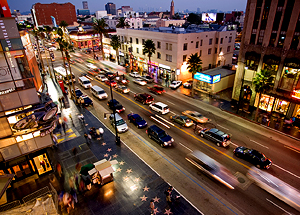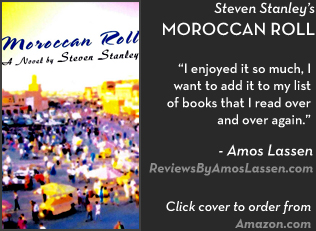
Anyone under the age of seventy may find it hard to believe there was home entertainment before television, but in the 1930s and ‘40s radio ruled the airwaves with variety shows which brought the voices of stars like Frank Sinatra, Dinah Shore, and Betty Grable into living rooms across America.
Those radio days come back to life in Walton Jones’ The 1940s Radio Hour, the short-lived 1979 Broadway musical which serves as Civic Light Opera Of South Bay Cities 2010 holiday offering. Though the show’s wisp of a book as well as songs which may seem like ancient history to the younger set could make it a tough sell to under40s, the Stephanie A. Coltrin-directed production is sure to appeal to older audiences, particularly as performed by an all-around stellar cast.
The first twenty or so fast and frantic, music-free minutes introduce us to its large cast of characters. There’s apoplexic WOV manager Clifton Feddington (Sam Zeller), Doris Day/Peggy Lee-like vocalist Ann Collier (Kim Arnett), Sinatra-inspired heartthrob Johnny Cantone (Christopher Newell), bubble-headed redhead Ginger Brooks (Misty Cotton), Lena Hornesque Geneva Lee Browne (Karole Foreman), dancing duo B.J. Gibson and Connie Miller (Estevan Valdes and Hanna Simmons), cantankerous doorkeeper/bookie Pops Bailey (Harrison White), sound effects man Lou Cohn (Richard Israel), wannabe featured vocalist Wally Ferguson (Dane Biren), and about-to-depart-for-the-front trumpeter Biff Baker (Ryland Dodge). (If all these characters seem a lot to keep straight, imagine how 1979 Broadway audiences must have felt with its original cast of twenty-nine.)
Once the all-male sixteen-piece band comes onstage at the Redondo Beach Performing Arts Center and the Christmas Eve broadcast begins, the accent is squarely on the music, with terrific performances of nearly two dozen 1940s hits by a uniformly stupendous ensemble. There’s “Kalamazoo,” “Daddy,” “Our Love Is Here To Stay,” “That Old Black Magic,” “Ain’t She Sweet,” “How About You,” “Blue Moon,” “Rose Of The Rio Grande,” “I’ll Never Smile Again,” “Boogie Woogie Bugle Boy,” “Blues In The Night,” “Jingle Bells,” “I Got It Bad And That Ain’t Good,” “You Go To My Head,” “Have Yourself A Merry Little Christmas,” “Strike Up The Band,” and “I’ll Be Seeing You.” The CLOSBC production cuts a couple of the original production’s songs and adds “I’ll Be Home For Christmas” to up the holiday feel.
Especially amusing are the show’s many commercial breaks, with jingles for Pepsi Cola, Chiquita Bananas, and Servel Electrolux in addition to authentic commercials for Cashmere Bouquet toilet soap, Sal Hepatica laxative, Nash automobiles, and numerous other ‘40s-era sponsors. It’s fun too to see how sound effects were created live in studio, especially those which accompany a rapid-fire retelling of the first half of Charles Dickens’ A Christmas Carol.
Vocally, it’s hard to imagine improving on Arnett, Cotton, Dodge, Foreman, and Newell, who wow the audience as the Radio Hour’s chief vocalists. (Cotton has great fun as the dizty, gum-chewing Ginger, who can’t seem to decide which skin-tight outfit to wear—for a radio broadcast!) Biren, Israel, White, and Zeller get to show off their razor-sharp comedic gifts, and Simmons and Valdes prove themselves bona fide triple-threats, executing choreographer Heather Castillo’s high-energy, acrobatic dance steps to perfection.
Director Coltrin makes the absolute most of the material, and the big band sound doesn’t get any better than under the baton of musical director Daniel Gary Busby in the role of band leader Zoot Doubleman. Christopher Beyries has designed a stunning, authentically appointed period radio studio set, whose staircase to WOV’s upper level offices gives Zeller in particular quite a workout. Darrell J. Clark’s lighting has a great holiday feel, and with the exception of some too-long skirts, Christa Armendariz’s costumes have just the right 1940s look—though where are bobbysoxer Connie’s bobby sox? Thumbs up go (as always) to John Feinstein’s sound design. Nicole Wessel is production stage manager.
Whether you like or love The 1940s Radio Hour will depend on your fondness for WWII music and how much it matters to you that the show is rather more revue than book musical. Regardless, it’s hard not to rave about the talent on stage and the sensational performances each and every cast member delivers.
CLO of South Bay Cities, Redondo Beach Performing Arts Center, 1935 Manhattan Beach Boulevard, Redondo Beach.
www.civiclightopera.com
–Steven Stanley
December 7, 2010
Photos: Alyssa Brennan





 Since 2007, Steven Stanley's StageSceneLA.com has spotlighted the best in Southern California theater via reviews, interviews, and its annual StageSceneLA Scenies.
Since 2007, Steven Stanley's StageSceneLA.com has spotlighted the best in Southern California theater via reviews, interviews, and its annual StageSceneLA Scenies.







 COPYRIGHT 2025 STEVEN STANLEY :: DESIGN BY
COPYRIGHT 2025 STEVEN STANLEY :: DESIGN BY